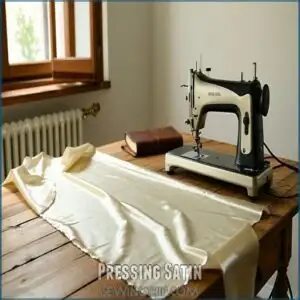This site is supported by our readers. We may earn a commission, at no cost to you, if you purchase through links.
 Sewing satin can feel like taming a slippery fish, but it’s absolutely doable with the right approach.
Sewing satin can feel like taming a slippery fish, but it’s absolutely doable with the right approach.
Start by cutting your fabric with sharp shears or a rotary cutter, stabilizing it with tissue paper for clean edges.
Use a fine needle (size 9 or 11) and matching lightweight thread for smooth stitching.
Adjust your stitch length to around 1.5 mm to prevent puckering, and sew slowly—patience is your best friend here.
Always press seams on the wrong side with low heat and a pressing cloth to protect that gorgeous sheen.
Master these tips, and satin will behave beautifully in your hands!
Table Of Contents
- Key Takeaways
- What is Satin?
- Getting Started With Satin
- Sewing Techniques for Satin
- Handling Satin With Care
- Tips for Seam Allowance and Layout
- Storing Satin for Optimal Results
- Choosing The Right Pins for Satin
- Proper Needle and Thread Selection for Satin
- Sewing Satin: Best Practices and Techniques
- Additional Considerations for Sewing With Satin
- Frequently Asked Questions (FAQs)
- Conclusion
Key Takeaways
- Use a sharp needle (size 70/10 or 80/12) and lightweight thread to prevent snags and puckering.
- Pin carefully within seam allowances and test your sewing machine settings on scrap satin before starting.
- Press seams on the wrong side with low heat and a pressing cloth to protect the fabric’s sheen.
- Finish edges with a zigzag stitch, pinking shears, or a serger to prevent fraying.
What is Satin?
Satin, with its glossy charm on one side and softness on the other, has long been a favorite in luxury fabrics.
Once reserved for silk, today’s satin often features polyester or nylon, making it more accessible. Its weave structure—where threads float over others—creates that unmistakable sheen.
From bridal gowns to eveningwear, satin fabric drapes beautifully, elevating any design.
But, it’s not all glamour; satin sewing requires patience. Its slippery texture can intimidate, yet the fabric’s rewards are worth it. Mastering satin handling means turning its tricky nature into pure elegance, transforming it into designs that truly shine.
Getting Started With Satin
Getting started with satin means focusing on preparation to save yourself headaches later. From picking the best tools to handling the slippery texture, a little planning makes all the difference.
Storing Satin
Keeping satin fabric smooth and luscious starts with storing it right.
Ditch the folds and go for fabric rolling—use a sturdy cardboard tube to keep creases at bay.
Satin folding can imprint unsightly lines, so let the fabric rest gently.
For ideal textile care, stash it in dry, climate-controlled storage containers to shield it from moisture or heat.
Proper fabric storage isn’t just about looks—it’s about fiber preservation for stress-free satin sewing tips later.
Cutting, Aligning & Marking
Cutting satin can feel like herding cats, but precision cutting is your key.
Work with sharp shears or a rotary cutter for clean edges. Stabilize slippery fabric using tissue paper or a non-slip mat.
For proper satin alignment, check the fabric grain. Use tailor’s chalk or washable Marking Tools for gentle edge control—because pinholes don’t flatter glossy satin.
Choosing The Right Needle and Thread
Choosing the right tools for satin sewing is half the battle. Use these tips: Choosing the right hemming satin techniques is essential for a polished finish.
- Needle Size: A size 70/10 or 80/12 satin sewing needle works best.
- Thread Types: Fine polyester or silk thread minimizes puckering.
- Fabric Tension: Adjust machine tension for smooth stitching.
- Needle Selection: Replace dull needles often to avoid snags.
Sewing Techniques for Satin
Mastering the right techniques for sewing satin is key to tackling its slippery, delicate nature.
With a few expert tips, you’ll create beautiful, smooth seams that look polished and professional every time.
Sewing Satin Seams
Sewing satin seams is like taming a slippery opponent—it needs patience and focus.
Use short stitch lengths to prevent puckering and reinforce them for durability. Hand baste seams first for stability, especially when working on curves.
Pin carefully within seam allowances to avoid holes.
For a polished look, consider satin edge binding or finishing seams with precision.
Investing in sewing machines can greatly improve the quality of your satin seams.
| Technique | Purpose | Tools Needed | Best for | Notes |
|---|---|---|---|---|
| Short stitch lengths | Prevents puckering | Sewing machine | All seams | Adjust tension for smooth results |
| Hand basting | Adds stability | Needle, thread | Curved seams | Remove before final stitching |
| Pinning in allowance | Avoids visible marks | Fine satin pins | All seams | Place pins horizontally |
| Satin seam reinforcement | Improves durability | Strong polyester thread | Stress-prone areas | Test on fabric scrap first |
| Satin edge binding | Neat seam finish | Bias tape scissors Exposed seams | Great for formal satin garments |
Pressing Satin
When ironing satin, less is more. Use low heat and a pressing cloth to avoid ruining its silky sheen. Focus on the wrong side to prevent marks, and skip the steam—it’s risky business for satin.
- Press lightly to smooth wrinkles without crushing the fabric.
- Clip seams on curves to lay them flat.
- Control heat carefully to protect the satin finish.
Finishing Satin Edges
Fraying satin edges can feel like a race against time, but with proper seam finishing, you’ll keep those strands in check.
Use a serger, zigzag stitch, or pinking shears to secure edges. For extra finesse, consider binding with bias tape.
To maintain the quality of your satin fabric, understanding satin care is essential for its longevity.
| Method | Benefits | Difficulty Level | Tools Needed | Suggested Use Cases |
|---|---|---|---|---|
| Serging | Durable and neat finish | Moderate | Serger | Professional garments |
| Zigzag Stitch | Simple and effective | Easy | Sewing machine | Everyday satin projects |
| Double Stitching | Reinforced edges | Easy | Sewing machine | Areas needing extra strength |
| Pinking Shears | Quick fray prevention | Easy | Pinking shears | Casual or quick projects |
| Binding with bias tape | Polished look | Moderate | Bias tape, sewing link | Dresses or formalwear |
Handling Satin With Care
When working with satin, you’ll need to handle this slippery fabric with extra care and precision to avoid unwanted snags, wrinkles, or marks.
By mastering a few key techniques like using sharp tools, minimizing fabric handling, and pressing gently, you’ll transform this tricky material into a stunning, professional-looking garment.
Avoiding Water Spots
Dodge water-induced nightmares on your delicate satin project with these game-changing ironing tips:
- Shield your fabric with a crisp press cloth
- Disable steam settings completely
- Stick to low to medium heat zones
- Glide your iron, never press hard
- Allow fabric to cool before handling
Protect that luxurious sheen and keep your satin pristine with strategic water spot prevention.
Smoothing Rough Surfaces
Like a detective hunting for imperfections, run your fingers across satin’s delicate surface before cutting.
Snags can ambush your project, turning luxurious fabric into a nightmare of pulled threads and puckered seams.
Gently inspect each piece, feeling for rough spots that could sabotage your textile masterpiece.
Use fine sandpaper or a soft pumice stone to smooth out any stubborn surface irregularities.
Handle the fabric with kid gloves, treating it like the precious material it is.
Your careful touch will guarantee a flawless finish.
Pressing Without Steam
Smooth out satin’s temperamental nature with smart ironing techniques. Always use a press cloth and work from the wrong side on low heat.
Steam is your enemy – it’ll leave water spots faster than you can say "ruined dress."
Hang bias-cut pieces before hemming, letting gravity help them settle into their final, fabulous shape.
Tips for Seam Allowance and Layout
Master seam margin control with these pro satin sewing strategies! When working with this slippery fabric, precision is your secret weapon.
Here’s how to nail your layout:
- Position pins exclusively within seam allowances to prevent permanent fabric marks.
- Cut pattern pieces accounting for fabric grain and natural drape.
- Increase your seam width to 1/2 inch, giving yourself extra insurance against fraying.
To further improve your skills, understanding sewing techniques is important for handling delicate fabrics like satin.
Slow and steady wins the satin sewing game.
Storing Satin for Optimal Results
After perfecting your seam allowances, let’s talk about keeping your satin fabric looking pristine. Think of satin storage as protecting a delicate treasure. For superior results, consider visiting a store satin resource for additional guidance.
To prevent unwanted creases, gently roll your fabric on a cardboard tube, carefully aligning the grain. Wrap the roll loosely in acid-free tissue paper, securing it with soft twine or ribbons – never tight rubber bands that’ll leave permanent marks.
For pattern pieces, layer them between tissue sheets to maintain their shape. Stash your fabric in cool, dry places away from direct sunlight.
With these fabric care techniques, you’ll preserve your satin’s luxurious sheen and guarantee it’s ready for your next stunning project.
Choosing The Right Pins for Satin
To avoid damaging the delicate surface of satin, choose your pins carefully.
Fine, glass-head pins are your best bet for preventing snags and minimizing visible puncture marks on this tricky, shimmering material.
Choosing The Right Pins:
Now that you’ve rolled your satin fabric neatly, it’s time to talk pins – your secret weapon in taming this slippery fabric. Choosing the right pins can make or break your sewing project.
When sewing with satin, using fine glass head pins is essential for achieving professional results. Precision matters when working with satin’s unforgiving surface.
- Opt for fine, glass-head pins with sharp points
- Select pins with minimal heads to avoid fabric damage
- Use silk pins or extra-fine pins for delicate satin
- Choose pins with smooth, polished surfaces
Consider Pin Placement:
Once you’ve picked your pins, placement becomes your secret weapon in satin sewing techniques.
Position pins within the seam allowance to minimize fabric damage, angling them parallel to the fabric’s weave.
Your pinning strategy should be gentle yet strategic—think of it as a delicate dance, guiding your satin without leaving a trace of its partner’s touch.
Preventing Pinholes in Satin
Keeping your satin fabric pristine means mastering the art of pin placement to dodge those pesky pinholes.
Here’s your game plan for addressing this delicate fabric challenge:
- Use ultra-fine pins with glass or silk weights to minimize fabric damage.
- Pin within seam allowances or hidden areas to avoid visible marks.
- Select sharp, thin needles and insert pins perpendicular to the fabric edge.
Your satin project deserves a flawless finish.
Proper Needle and Thread Selection for Satin
When sewing satin, you’ll need to choose your needle and thread with surgical precision to prevent fabric damage and achieve professional-looking results.
Your best bet is to select fine, sharp needles like Microtex in smaller sizes (70/10 or 80/12) and pair them with lightweight polyester thread that’ll glide smoothly through this delicate, slippery fabric.
Needle Size for Satin
Because satin’s delicate nature demands precision, selecting the right needle size is essential for a flawless finish.
Your sewing success hinges on choosing fine needles that glide through fabric without leaving a trace.
| Needle Size | Fabric Weight | Recommended Use | Pro Tip |
|---|---|---|---|
| 70/10 | Lightweight Satin | Delicate Garments | Gentle Touch |
| 80/12 | Medium Weight | Blouses, Dresses | Balanced Performance |
| 90/14 | Heavier Satin | Structured Pieces | Careful Approach |
| 60/8 | Ultra-Thin Satin | Lingerie, Fine Details | Precision Work |
Choosing The Right Thread
When working with satin, thread choice can make or break your project.
Opt for fine, lightweight polyester thread that glides smoothly and won’t weigh down the delicate fabric.
Matching thread color to your satin guarantees a professional finish, while considering the thread’s weight and yarn texture helps prevent puckering and maintains the fabric’s luxurious drape.
Adjusting Tension for Satin
After picking the perfect thread, your sewing machine tension becomes your secret weapon when working with satin. Mastering tension settings can make or break your project.
Here’s how to nail those tricky satin sewing machine settings:
- Start with a lower tension (around 3-4)
- Test on scrap fabric first
- Adjust gradually to prevent thread breakage
Slow and steady wins the race with delicate satin threads and requires mastering tension settings.
Sewing Satin: Best Practices and Techniques
Satin’s siren song of luxury can quickly turn into a seamstress’s nightmare if you’re not prepared. Master the art of sewing this slippery fabric by treating each seam like a delicate dance partner. Reduce your machine’s tension and opt for a narrow seam allowance to keep fabric misbehavior in check.
Hand-basting curved sections provides a lifeline of stability, preventing those dreaded ripples and puckers that can ruin your carefully chosen satin fabric selection. Understanding low heat ironing techniques is essential for maintaining the fabric’s appearance after sewing.
Seam finishing is your secret weapon – a serger or zigzag stitch will be your shield against fraying edges. When pressing, use a protective cloth to maintain that gorgeous sheen, and gently guide the fabric through your sewing machine with a steady, confident touch. Your satin project deserves nothing less than perfection.
Additional Considerations for Sewing With Satin
Sewing with satin requires a finesse that goes beyond basic fabric handling, challenging even experienced sewists with its slippery and delicate nature.
You’ll want to arm yourself with specialized techniques and tools to transform this luxurious material into a stunning garment without frustration or costly mistakes.
Choosing The Right Needles
With needles as your sewing sidekick, mastering the right choice can make or break your satin project.
Here’s your needle survival guide:
- Choose Microtex or sharp needles (sizes 70/10 or 80/12)
- Opt for fine, lightweight needle materials
- Replace needles frequently to prevent fabric damage
- Match needle size to fabric weight
- Consider fabric tension when selecting needles
Your fabric’s smooth journey starts here.
Proper Pressing Techniques
When handling satin, treat your iron like a delicate dance partner. Use a low heat setting and a protective pressing cloth to prevent glazing or scorching.
Press seams open on the wrong side, folding carefully to maintain the fabric’s luxurious sheen.
To achieve the best results, understanding low heat ironing techniques is essential. Avoid steam and water spots, guiding your iron with precision and gentleness.
Dealing With Slippery Fabric
Taming satin’s slippery nature takes strategy. Start with fabric preparation: lay it flat and anchor with tissue paper or pattern weights to reduce slippage.
A walking foot guide works wonders for smooth sewing.
Prevent shifting by pinning carefully; opt for pin selection that avoids damage.
Master satin fabric handling, and you’ll breeze through this tricky material with confidence.
Frequently Asked Questions (FAQs)
How to sew with satin fabric?
Sewing with satin is like walking on ice—it’s slippery but manageable.
Use sharp needles, lightweight thread, and adjust tension carefully.
Pin sparingly, press seams with a cloth, and finish edges to prevent fraying.
How to set up the sewing machine for satin stitching?
Use a sharp Microtex needle (size 70/10 or 80/12) and fine polyester thread. Lower tension slightly to avoid puckering, adjust stitch length to 2-5mm, and test settings on scrap satin first.
How do you sew Satin on a sewing machine?
Working with satin can feel like wrangling a slippery eel!
Anchor it with pattern weights, adjust your machine tension, and use a fine needle and lightweight thread.
Baste seams first, then stitch slowly for control.
Why is Satin so hard to sew?
Satin’s slippery, glossy texture makes it tricky.
It shifts while cutting and sewing, puckers easily, and frays like nobody’s business.
It’s like trying to tame a silk cloud; patience and the right tools are essential.
Is it difficult to sew with satin?
Sewing with satin is like trying to hold onto a slippery fish—it shifts, frays, and puckers easily.
You’ll need sharp tools, steady hands, and patience, but care and precision make it manageable.
What is the best stitch for satin sewing?
A short, straight stitch with a length of 0–5mm works best for satin.
It keeps seams neat and avoids puckering.
Pair it with a sharp needle and lightweight thread for a smooth finish.
Can you sew satin on a sewing machine?
Think of sewing satin on a machine like handling a mischievous pet—manageable with the right tricks.
Use a fine needle, adjust tension carefully, and go slow.
A walking foot helps prevent fabric shifts.
Do you need a special needle to sew satin?
You’ll want a Microtex or sharp needle for satin.
Its fine point glides through the slippery fabric without snagging.
Skip the dull needles—satin’s delicate texture doesn’t forgive mistakes, and snags can ruin the look.
How do I prevent satin edges from fraying?
Prevent satin edges from fraying by using a zigzag stitch, pinking shears, or a serger.
For added durability, and to keep your fabric neat and intact, you can also apply bias tape or seam sealant.
Can satin be dyed without ruining its texture?
Satin can be dyed, but it’s tricky.
Silk satin takes dye beautifully, while polyester satin requires special synthetic dyes.
Always test a scrap first—hot water or incorrect dye types can warp satin’s smooth texture.
Conclusion
Satin sparks creativity but can be slippery and stubborn. Mastering how to sew with satin takes sharp tools, subtle stitches, and smart techniques.
Slow down, press carefully, and use the right pins, needles, and lightweight thread to control this tricky fabric.
Treat seams and edges with care to keep that elegant sheen intact.
With practice and patience, satin will stop slipping and start shining in your hands—ready to transform into something stunning, silky, and special.

















